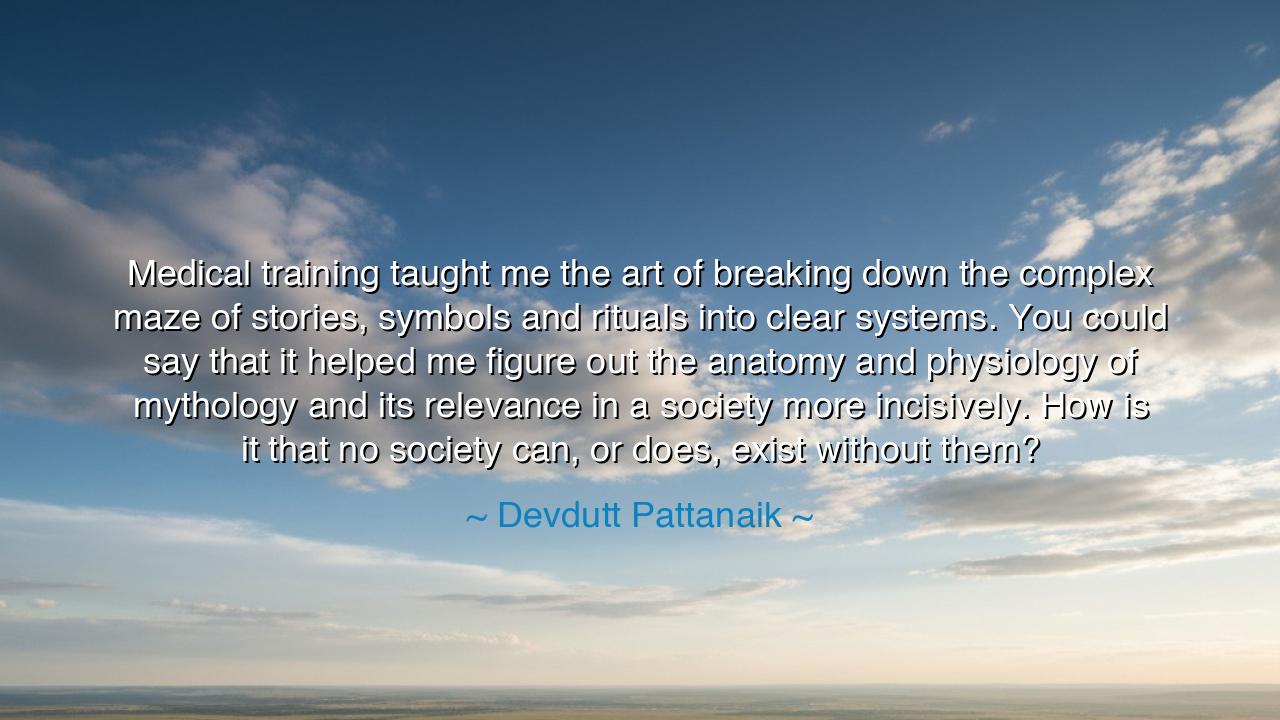
Medical training taught me the art of breaking down the complex
Medical training taught me the art of breaking down the complex maze of stories, symbols and rituals into clear systems. You could say that it helped me figure out the anatomy and physiology of mythology and its relevance in a society more incisively. How is it that no society can, or does, exist without them?






In the luminous words of Devdutt Pattanaik, “Medical training taught me the art of breaking down the complex maze of stories, symbols and rituals into clear systems. You could say that it helped me figure out the anatomy and physiology of mythology and its relevance in a society more incisively. How is it that no society can, or does, exist without them?” we find a bridge between the two oldest forms of human understanding — science and story. His words are an offering from one who has walked in both worlds: the realm of the healer, who studies the body with logic and precision, and the realm of the mythmaker, who studies the soul through symbol and imagination. Through this union, Pattanaik unveils a truth long forgotten in the modern age — that mythology and medicine share the same purpose: to reveal the hidden structure of life and bring meaning to the mysteries of existence.
The origin of this quote lies in Pattanaik’s own journey. Trained as a medical doctor before becoming one of India’s most profound mythologists, he learned to dissect the physical body before turning his gaze toward the metaphysical body of culture — the stories and beliefs that keep a civilization alive. His medical discipline taught him to see systems, patterns, and causes beneath chaos. He applied this same analytical eye to the epics and symbols of humanity, discovering that myths, too, have anatomy and physiology — structure and function, rhythm and purpose. In every tale, every ritual, and every symbol, he found not superstition, but the circulatory system of human consciousness, pumping life into communities and binding generations across time.
To the ancients, mythology was never fantasy. It was the language through which truth clothed itself in metaphor. Just as the physician studies the body to heal its wounds, the sage studied myth to heal the spirit. In every civilization — from the hymns of the Vedas to the dialogues of Plato, from the Egyptian Book of the Dead to the stories of the Bible — myth served as a living anatomy of meaning, mapping the invisible organs of the human soul: fear, love, duty, and faith. Pattanaik’s insight reminds us that a society without mythology is like a body without blood — hollow, lifeless, and without direction.
Consider the story of Hippocrates, the father of Western medicine. Before him, disease was thought to be the curse of gods or the punishment of fate. But Hippocrates looked deeper — he sought the natural causes behind the symptoms, transforming fear into understanding. Pattanaik walks a similar path, though in reverse. He takes the scientific mind and turns it toward myth, revealing that the stories we dismiss as superstition are, in truth, maps of the mind, psychological blueprints that explain how humans seek order in a world of uncertainty. His “anatomy of mythology” shows us that behind every god is an idea, behind every ritual a principle, and behind every story a mirror held up to our own inner nature.
Yet his words also contain a question, one both haunting and humbling: “How is it that no society can, or does, exist without them?” The answer lies in the deep human hunger for meaning. Science tells us how we live; mythology tells us why. The microscope reveals the cells of the heart, but the story reveals the purpose of its beating. When a civilization loses its myths, it loses its vision — it becomes efficient, but empty; advanced, but anxious. The stories of the past are not chains that bind us, but roots that nourish us, giving form to the formless and direction to the restless.
There is a profound lesson here for the modern world: in our pursuit of precision, we must not forget poetry. The scientist must learn reverence, and the storyteller must learn rigor. The mind that can dissect the body must also be able to interpret the soul. Pattanaik’s union of medicine and mythology teaches that wisdom is born not from choosing one path, but from balancing both — the clarity of logic with the compassion of wonder. Every physician should remember that healing is not only physical but spiritual; every leader should remember that progress must be guided by stories that uplift the human heart.
So let us, as he did, learn to read both the body of science and the soul of story. Let us look upon our myths not as relics, but as organs still alive, still breathing within our collective consciousness. For as Devdutt Pattanaik reminds us, the heart of every society beats to the rhythm of its myths — and when we learn to understand that rhythm, we rediscover not only who we are, but why we are.






AAdministratorAdministrator
Welcome, honored guests. Please leave a comment, we will respond soon